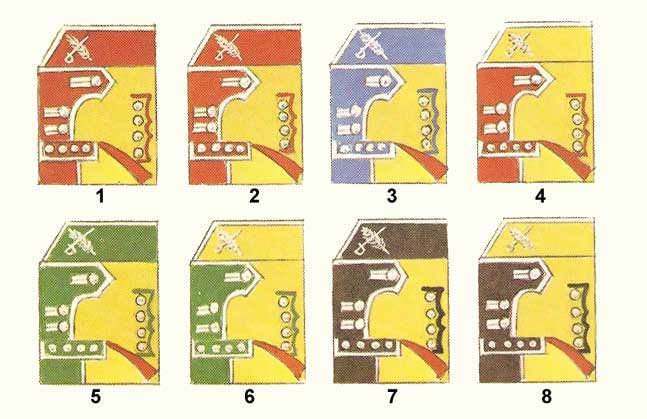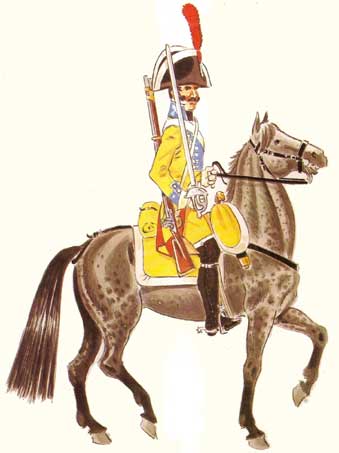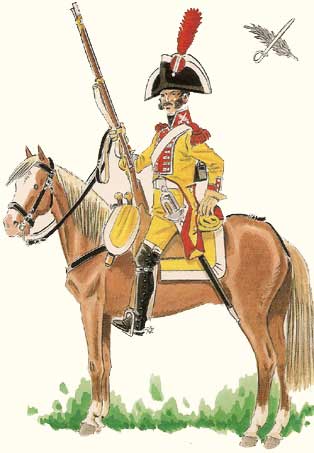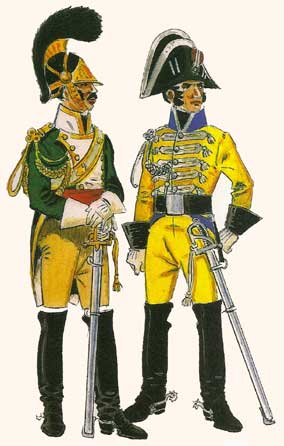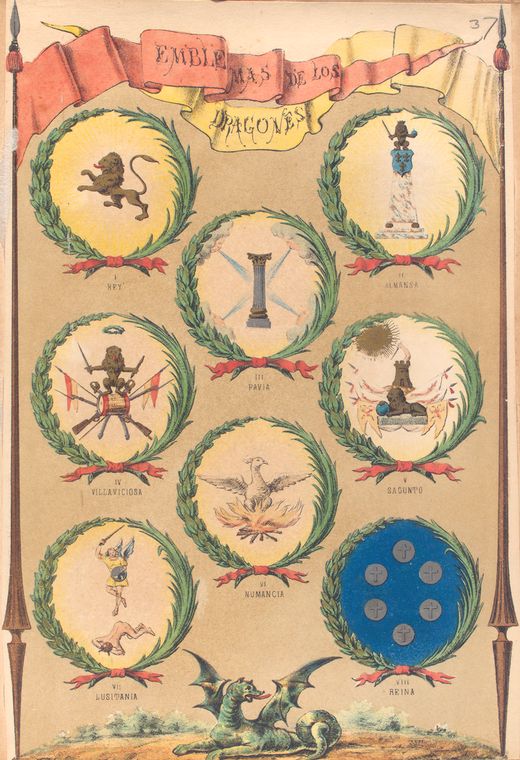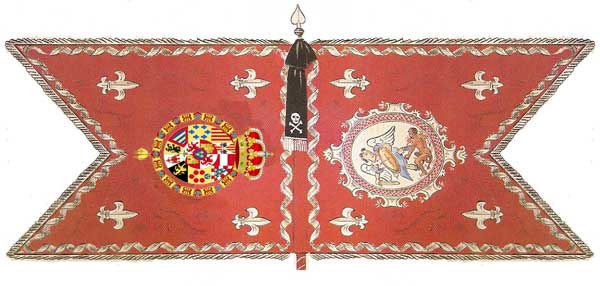|
Spanish Dragoon RegimentsHistoryThe first dragoon regiment (Regimiento de Dragones del Rey) was created as early as 1674. From the beginning of the 18th century they had worn lemon yellow coats. In 1803 there were eight dragoon regiments, but the cavalry regulations that year disbanded all the dragoon regiments, converting six to light cavalry (Cazadores de Caballería) and the remaining two to Hussars. It was realised that the dragoons had an important role to play, and in 1805 the eight regiments were converted back to dragoons. At the start of the Peninsular war, the following eight dragoon regiments existed...
Organisation1803The cavalry regulations of 1803 stated that from 30 January 1803, all cavalry regiments were to have the same organisation, consisting of a regimental staff and 5 squadrons each of two companies. The first four squadrons were field squadrons and carried standards, the 5th squadron was a to be a depot squadron and had no standard. The regimental staff consisted of:
1 Colonel Each company consisted of:
1 Captain The Carabineros were elite troopers selected in for "the best behavior, agility and ruggedness" mounted on the best horses often used as scouts or guides. Men without horses would remain at the depot. Thus a regiment at full establishment should have consisted of 674 men and 544 horses plus officers. 1805The eight regiments reverted from light cavalry and hussars to dragoons. Their organisation was not changed. 1808In May 1808 the Regiments had the following strengths...
The Almansa and Villaviciosa were almost at full strength with horses, this was done at the cost of some of the other regiments. Unfortunately these two regiment had to return to Spain from Denmark without their horses. They were landed in Galicia and then marched to Extremadura to obtain remounts. On 7 July 1808 the Cáceres Dragoons were formed around a cadre from the Lusitania Dragoons with a strength of 528 troopers in 4 squadrons. On 1 August 1808 the Castilla Dragoons were formed with a strength of 300 troopers in 2 squadrons. A year later they became part of the Borbón Heavy Cavalry Regiment. On 15 September 1808 the Madrid Dragoons were formed with a strength of 948 troopers in 4 squadrons. A year later they became light cavalry: Cazadores de Madrid. On 29 September 1808 the Granada Dragoons were formed around a cadre from the Numancia Dragoons with a strength of 600 troopers in 4 squadrons. They were disbanded on 7 September 1813, being transferred into the de la Reina and Sagunto dragoon regiments. From 1 October 1808, all cavalry regiments were to have the same organisation, consisting of a regimental staff and 4 squadrons each of three companies. The staff consisted of 12 officers and 6 men. Each company had 3 officers and 61 men but only 53 horses. Thus a full strength regiment could field at most 654 officers and men, although it is unlikely that the establishment was reached because of the trying times! 1809From 30 January 1809, each company was to consist of 81 men and 71 horses. On 15 July 1809, all cavalry regiments were reduced to 3 squadrons. 1810On 6 July 1810 the Soria Dragoons were formed with a strength of 300 troopers in 3 squadrons. They were disbanded at the end of the war. 1811On 6 April 1811, the greatly weaken Spanish cavalry was reformed, it was planned to retain ten dragoon regiments:
It seems confusing to find Madrid still on the list of Dragoons, but it was removed later in the year and added to the Cazadores. In addition there was one provincial squadron of dragoons: Soria. Due to the shortage of horses, in each regiment two squadrons were to be mounted and one dismounted. UniformsRomana's CorpsThe uniforms of Romana's Corps were well documented by the Suhr brothers when they were in Hamburg in late 1807 before moving to Denmark in early 1808. The Almansa and Villaviciosa Regiments still wore the "old style" green light cavalry uniforms. They did not receive the new 1805 model lemon yellow uniforms until they returned to the Peninsular in 1808. Start of the WarIn 1805 lemon yellow uniforms with regimental distinctions were re-adopted. The Dragoons wore a lemon yellow long-tailed coat with red turnbacks, white metal buttons and a crossed sword and quill embroidered on the collar. The collar, cuffs, cuff flaps and lapels were piped white. The following regimental distinctions applied...
The waistcoat and breeches were lemon yellow. Footwear was ideally black long cavalry boots but was sometimes replaced with long black gaiters buttoning up the outside worn with shoes. The headgear was a black bicorne, edged white with the red Spanish cockade and red plume. They were issued with a lemon yellow cape, with a collar in facing colour. The saddlecloth was lemon yellow edged in white. Dragoons were armed with a straight sword, two pistols and a musket. The musket was usually hung over the left shoulder by its sling although the regulation a traditional method for carrying a dragoon musket was secured barrel up by a strap on the right side of the pommel. Sergeants did not carry the musket. Officers: They had the same style uniform as that of the troopers but of better quality. The coat was long tailed and had lace, buttons, badges and epaulettes in silver. The bicorne was edged with silver lace. Long black boots were worn. Their saddlecloth was lemon yellow edged in silver. Trumpeter: They had the same style uniform as that of the troopers, with the coat colours reversed (red coat with lemon yellow turnbacks) and the usual regimental distinctions. Where possible, they would have ridden greys. The saddlecloth may have been red edged in white and the cape red (Suhr shows these in Hamburg). Trumpets were brass, and it was common practice to have the regiment's arms on the trumpet banner. There is no existing trumpeter uniform or illustration, so I have chosen to follow Bueno's interpretation of the regulations. An alternative interpretation is that the coat was red and the turnbacks, collar, cuffs, cuffs flaps, lapels and rear pocket piping were all lemon yellow regardless of the regiment's facing colour.
Later WarThe 1805 uniform regulations applied to the dragoons throughout the war, however as the war progressed the dragoon uniforms took on a simpler and more modern form. Coats became coatees and bicornes could be replaced by helmets or bell-topped shakos; one illustration shows a trooper in coatee and bell-topped shako for the Battle of Ocaña in November 1809 but I can find no other evidence for or against this. The Granada Dragoons had lemon yellow coatees with shorter tails than the original dragoon coats, without lapels and with a deep sky blue facing colour. The collar emblem was a brass 7 instead of that normally worn by dragoons. Unlike the other regiments, buttons were brass and officers would have had gold buttons and epaulettes. They wore a black leather helmet with black crest and brass fittings instead of the bicorn. On campaign they wore grey overalls with a lemon yellow stripe.
The Almansa Dragoons are shown wearing a lemon yellow single breasted coatee with shorter tails than the original dragoon coats. The officer's silver chest lace, in imitation of the light cavalry, is unusual and might be unique for this high ranking officer. This Numancia Dragoons were nearly wiped out in the two sieges of Zarragosa. The regiment was then reformed Valencia in the spring of 1809 and it is probable that it was then they received their new uniform. The regiment had worn green prior to receiving their lemon yellow coats at the beginning of the 18th century and again between 1800-1802. The coat was green with white facings and yellow lace (gold for officers). Buttons were brass (gold for officers). They wore buff breeches and long cavalry boots. They wore a black leather helmet with black crest and brass fittings. The crimson or red sash is unusual and may have been worn in imitation of British and Portuguese officers. The saddlecloth was probably green edged yellow lace (gold for officers).
Rank distinctionsThis list is based upon the 1803 regulations. The rank of squadron commander was created in July 1810. Field grade officers are sometimes shown wearing two epaulettes as well as the lace stripes listed below.
Colonel: Three silver lace stripes around the coat cuffs. A "counter-epaulette" (with no fringe) was sometimes worn on the opposite shoulder of those who wore only a single epaulette. FlagsRoyal Decree 1768The Royal Decree 1768 required regiments of cavalry (guard, line, dragons and light) to use standards of damask or velvet in blue, red or white depending on the regiment, with the royal arms embroidered on the obverse (or front, when the stave is to the right), and the regiment's arms on the reverse (or rear, when the stave is to the right). In the 4 corners, the fleurs de lys must be embroidered in gold or silver. Cravats for all banners and flags should be of red colour, this being the national colour. The finials and fringes were to be gold or silver depending on the regiment. This decree remained in force until 1833. Dragoon RegimentsNo examples of dragoon standards exist from this period, so the following information is based on regulations, however the standards were not changed every time a new regulation came into force nor does it seem the regulations were always followed. Dragoon regiments carried one standard per squadron. The standard was usually a crimson/red swallow-tailed guidon. The fringes and embroidery and are usually in silver, but some could be in gold. Silver would be expected because of the white metal button colour. However as some dragoon regiments had previously had brass buttons and the standards could be quite old, this could explain why gold instead of silver was used occaisionally. The stave was red and yellow striped and the finial was silver. The stave was carried in a crimson shoulder belt adorned with silver edging. The cravats were red, this being the national colour. Although the royal arms should have been on the obverse, and the regiment's arms on the reverse, some regiments had these the opposite way round. The Vinkhuijzen collection of military uniforms from The New York Public Library contains the following drawing of the arms of the different dragoon regiments.
Lusitania DragoonsThe regiment had a scarlet swallow-tailed standard with silver fringes and embroidery. The edges were lined with images of silver chains. In the centre of the obverse (note not the reverse) was the regiment's arms of an image of St. Michael defeating Lucifer in an oval flanked by four fleur-de-lis. The stave was red and white striped and the finial was silver. The royal coat of arms was in the centre of the reverse. Following the battle of Madonna del Olmo in Savoy in 1744, the regiment received the nickname "dragoons of death" (Dragones de la muerte) and were granted the use of a black cravat bearing a white skull and crossbones.
Sources
|


